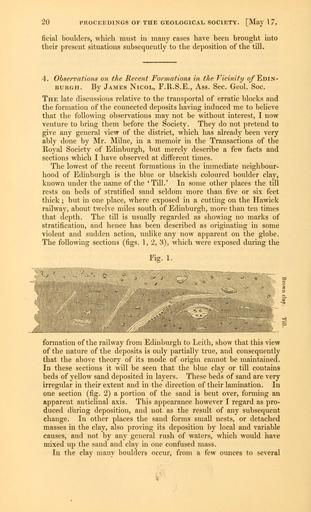MAKE A MEME
View Large Image

| View Original: | The_Quarterly_journal_of_the_Geological_Society_of_London_(12645071533).jpg (1210x1992) | |||
| Download: | Original | Medium | Small | Thumb |
| Courtesy of: | commons.wikimedia.org | More Like This | ||
| Keywords: The Quarterly journal of the Geological Society of London (12645071533).jpg 20 <br> PROCEEDINGS OF THE GEOLOGICAL SOCIETY May 17 <br> ficial boulders which must m many cases have been brought mto <br> their present situations subsequently to the deposition of the till <br> 4 Observations on the Recent Formations in the Vicinity q/ Edin- <br> burgh By James Nicol F R S E Ass Sec Geol Soc <br> The late discussions relative to the transportal of erratic blocks and <br> the formation of the connected deposits having induced me to believe <br> that the following observations may not be without interest I now <br> venture to bring them before the Society They do not pretend to <br> give any general view of the district which has already been very <br> ably done by Mr Milne in a memoir in the Transactions of the <br> Royal Society of Edinburgh but merely describe a few facts and <br> sections which I have observed at different times <br> The lowest of the recent formations in the immediate neighbour- <br> hood of Edinburgh is the blue or blackish coloured boulder clay <br> known under the name of the ' Till ' In some other places the till <br> rests on beds of stratified sand seldom more than five or six feet <br> thick ; but in one place where exposed in a cutting on the Hawick <br> railway about twelve miles south of Edinburgh more than ten times <br> that depth The till is usually regarded as showing no marks of <br> stratification and hence has been described as originating in some <br> violent and sudden action unlike any now apparent on the globe <br> The following sections figs 1 2 3 which were exposed during the <br> Fig 1 <br> formation of the railway from Edmburgh to Leith show that this view <br> of the nature of the deposits is only partially true and consequently <br> that the above theory of its mode of origin cannot be maintained <br> In these sections it will be seen that the blue clay or till contains <br> beds of yellow sand deposited in layers These beds of sand are very <br> irregular in their extent and in the direction of their lamination In <br> one section fig 2 a portion of the sand is bent over forming an <br> apparent anticlinal axis This appearance however I regard as pro- <br> duced during deposition and not as the result of any subsequent <br> change In other places the sand forms small nests or detached <br> masses in the clay also pro\ang its deposition by local and variable <br> causes and not by any general rush of waters w hich would have <br> mixed up the sand and clay in one confused mass <br> In the clay many boulders occur from a few ounces to several 35268654 109512 51125 Page 20 Text v 5 http //www biodiversitylibrary org/page/35268654 1849 Geological Society of London Biodiversity Heritage Library The Quarterly journal of the Geological Society of London v 5 1849 Geology Periodicals Smithsonian Libraries bhl page 35268654 dc identifier http //biodiversitylibrary org/page/35268654 smithsonian libraries Information field Flickr posted date ISOdate 2014-02-20 Check categories 2015 August 26 CC-BY-2 0 BioDivLibrary https //flickr com/photos/61021753 N02/12645071533 2015-08-27 10 55 28 cc-by-2 0 PD-old-70-1923 The Quarterly journal of the Geological Society of London 1849 Photos uploaded from Flickr by Fæ using a script | ||||